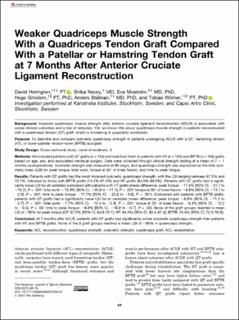| dc.description.abstract | Background: Impaired quadriceps muscle strength after anterior cruciate ligament reconstruction (ACLR) is associated with worse clinical outcomes and a risk of reinjuries. Yet, we know little about quadriceps muscle strength in patients reconstructed with a quadriceps tendon (QT) graft, which is increasing in popularity worldwide.
Purpose: To describe and compare isokinetic quadriceps strength in patients undergoing ACLR with a QT, hamstring tendon (HT), or bone–patellar tendon–bone (BPTB) autograft.
Study Design: Cross-sectional study; Level of evidence, 3.
Methods: We included patients with QT grafts (n = 104) and matched them to patients with HT (n = 104) and BPTB (n = 104) grafts based on age, sex, and associated meniscal surgery. Data were collected through clinical strength testing at a mean of 7 ± 1 months postoperatively. Isokinetic strength was measured at 90 deg/s, and quadriceps strength was expressed as the limb symmetry index (LSI) for peak torque, total work, torque at 30° of knee flexion, and time to peak torque.
Results: Patients with QT grafts had the most impaired isokinetic quadriceps strength, with the LSI ranging between 67.5% and 75.1%, followed by those with BPTB grafts (74.4%-81.5%) and HT grafts (84.0%-89.0%). Patients with QT grafts had a significantly lower LSI for all variables compared with patients with HT grafts (mean difference: peak torque: −17.4% [95% CI, −21.7 to −13.2], P < .001; total work: −15.9% [95% CI, −20.6 to −11.1], P < .001; torque at 30° of knee flexion: −8.8% [95% CI, −14.7 to −2.9], P = .001; time to peak torque: −17.7% [95% CI, −25.8 to −9.6], P < .001). Compared with patients with BPTB grafts, patients with QT grafts had a significantly lower LSI for all variables (mean difference: peak torque: −6.9% [95% CI, −11.2 to −2.7], P < .001; total work: −7.7% [95% CI, −12.4 to −2.9], P < .001; torque at 30° of knee flexion: −6.3% [95% CI, −12.2 to −0.5], P = .03; time to peak torque: −8.8% [95% CI, −16.9 to −0.7], P = .03). None of the graft groups reached a mean LSI of >90% for peak torque (QT: 67.5% [95% CI, 64.8-70.1]; HT: 84.9% [95% CI, 82.4-87.4]; BPTB: 74.4% [95% CI, 72.0-76.9]).
Conclusion: At 7 months after ACLR, patients with QT grafts had significantly worse isokinetic quadriceps strength than patients with HT and BPTB grafts. None of the 3 graft groups reached a mean LSI of >90% in quadriceps strength. | en_US |

